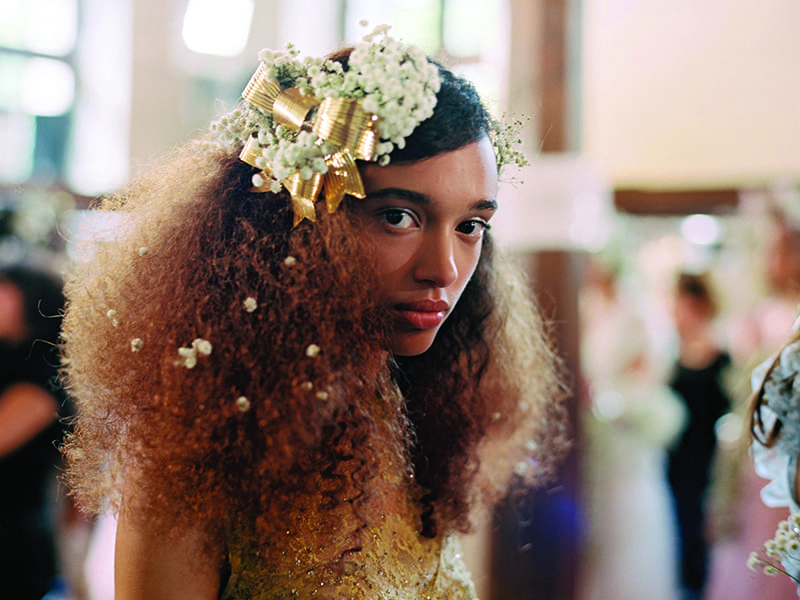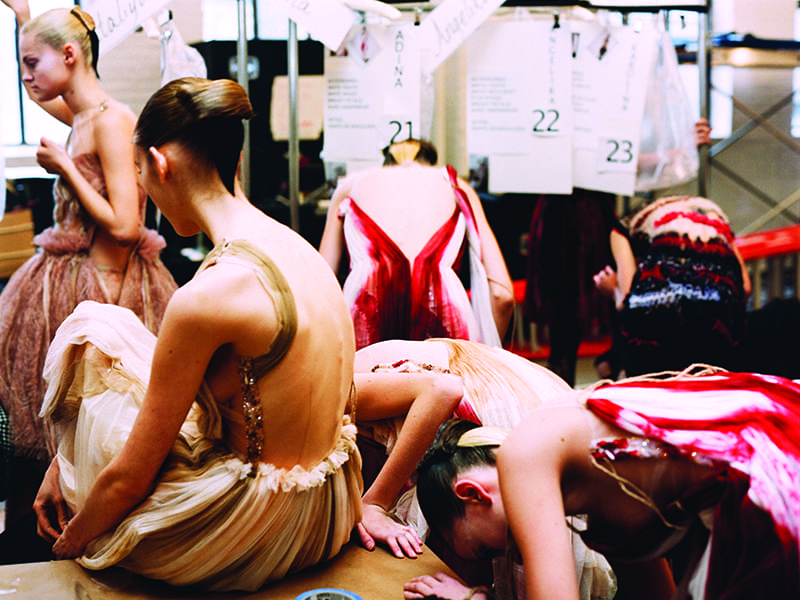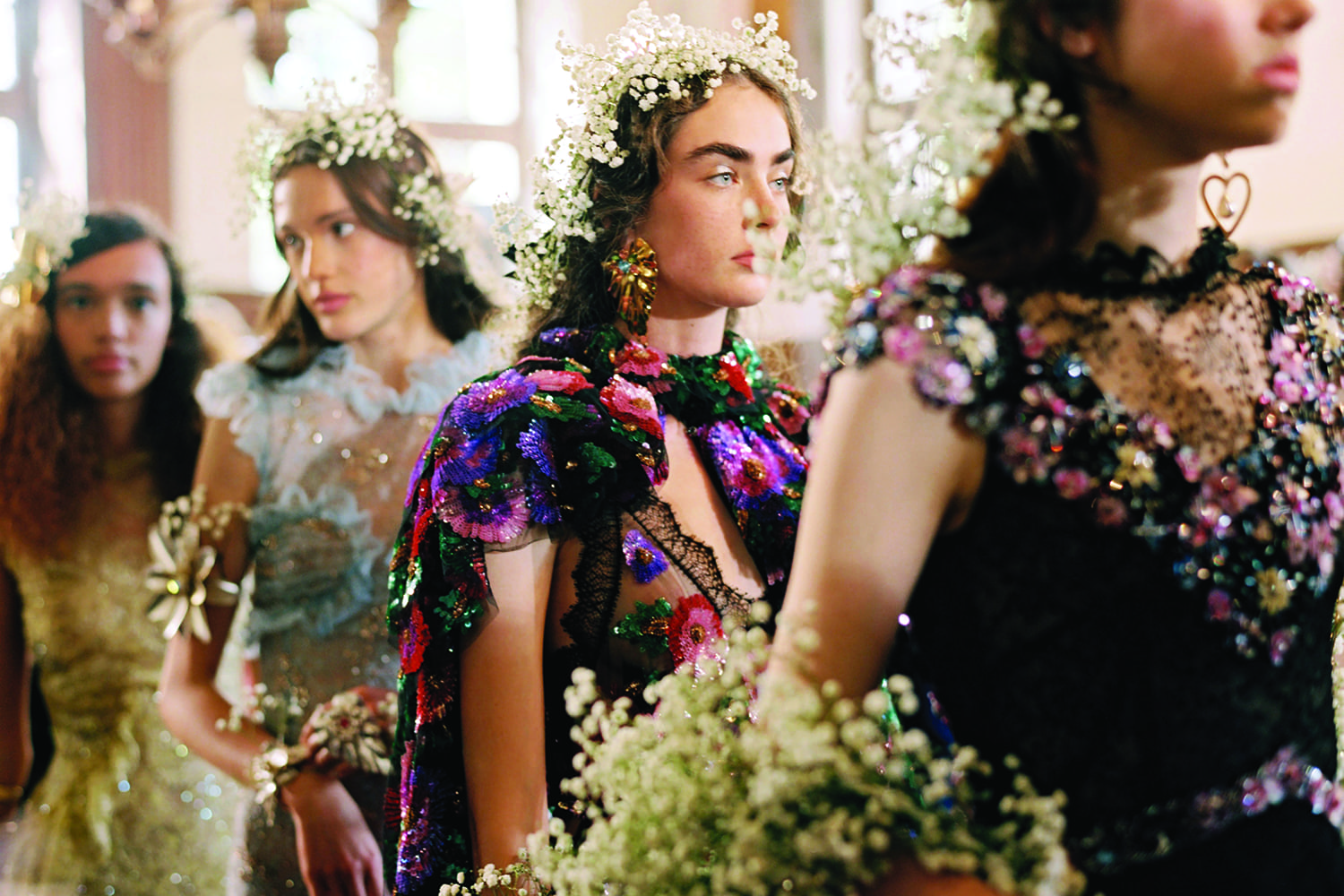When it comes to outfitting for the flower season, no one does it better than Rodarte.
By Karen Fragala Smith
Fit. Price point. Marketability. Licensing. It’s a fashion designer’s magic formula for commercial viability. To be successful at the retail level, a design house needs flattering and wearable garments, reasonable production costs, on-trend seasonal offerings and prolific licensing that includes perfume, sunglasses, handbags and shoes. This is the formula that made Michael Kors a billion-dollar brand. And it worked for Calvin Klein and Ralph Lauren before him. But for sisters Kate and Laura Mulleavy, founders of Rodarte, the most acclaimed brand in American fashion, commercial viability isn’t really a thing. Rodarte is all about creative expression. So it only makes sense that you’ll see more Rodarte gowns in their groundbreaking exhibition at the National Museum of Women in the Arts in Washington than in the dress department at Nordstrom.
“We are honored to be the first designers to have a fashion exhibition organized by the National Museum of Women in the Arts,” said Kate and Laura Mulleavy, who consider themselves artists who use clothing as a medium rather than utilitarians in service of the apparel industry. And while their dresses have appeared in dozens of museums around the world during the company’s 12 years in existence, the NMWA show is the most extensive Rodarte collection ever assembled, with nearly 100 runway looks precisely replicated from head to toe…

Fit price point. Marketability. Licensing. It’s a fashion designer’s magic formula for commercial viability. To be successful at the retail level, a design house needs flattering and wearable garments, reasonable production costs, on-trend seasonal offerings and prolific licensing that includes perfume, sunglasses, handbags and shoes. This is the formula that made Michael Kors a billion-dollar brand. And it worked for Calvin Klein and Ralph Lauren before him. But for sisters Kate and Laura Mulleavy, founders of Rodarte, the most acclaimed brand in American fashion, commercial viability isn’t really a thing. Rodarte is all about creative expression. So it only makes sense that you’ll see more Rodarte gowns in their groundbreaking exhibition at the National Museum of Women in the Arts in Washington than in the dress department at Nordstrom.
“We are honored to be the first designers to have a fashion exhibition organized by the National Museum of Women in the Arts,” said Kate and Laura Mulleavy, who consider themselves artists who use clothing as a medium rather than utilitarians in service of the apparel industry. And while their dresses have appeared in dozens of museums around the world during the company’s 12 years in existence, the NMWA show is the most extensive Rodarte collection ever assembled, with nearly 100 runway looks precisely replicated from head to toe.
The vibrant, sheer tie-dye and floral silk sheath from Rodarte’s Fall/Winter 2013 show and the lushly embroidered gown with epaulets from Spring/Summer 2018 are creative highlights. But take a gander in any direction, and you will see boundless creativity and artistry that you don’t have to be a fashionista to appreciate. A single Rodarte gown is built with up to a dozen fabrics, including tulle, organza, leather, lace, macrame, cheesecloth and silk. In most cases, the materials have been reworked with draping, pleating, dying or even burning to achieve unique textural distinctions. After cutting and assemblage, the garments are embellished with crystals, feathers, sequins, rosettes or silk flowers. The whole process, from ideation to completion, takes up to 150 hours, and the brand’s retail prices reflect the cost of labor and materials. It is not uncommon for a custom Rodarte gown to sell for $25,000. A typical Rodarte dress stocked by Bergdorf’s or Neiman’s runs for $10,000. Pricey as far as party frocks go, but a bargain if you think of a Rodarte as a Picasso, an O’Keeffe or, as one reviewer put it, “the fashion equivalent of a Basquiat.”
Even if you’ve never seen a Rodarte dress in a store, you’ve seen Rodarte dresses.
In 2009, Michelle Obama wore Rodarte for her famous White House meeting with the Queen of Jordan. In 2010, Rodarte designed the tulleand-feather dance costumes for the film “Black Swan,” and when Natalie Portman accepted the Best Actress Oscar for her performance in the film, she was wearing a plum silk Rodarte gown. Taylor Swift wore Rodarte on the February 2013 cover of Vogue, as did Katy Perry a few months later. Rodarte is the red carpet choice for bold stars and ingenues, including Lady Gaga, Nicole Kidman, Beyoncé, Julianne Moore, Ruth Negga, Rihanna, Chloe Sevigny, Tilda Swinton and Kerry Washington.
In 2009, Rodarte was named the Womenswear Designer of the Year by the Council of Fashion Designers of America, the most prestigious award in the apparel industry. Remarkably, this was just four years after the company’s founding. Unlike the majority of their peers, the Mulleavy sisters are self-taught and have no formal training in fashion design. Kate studied art history, and Laura focused on literature when they attended the University of California at Berkeley. After graduating in 2001, the sisters moved back home with their parents in Northern California and spent their days watching horror movies and reading books on couture sewing. Before long, they scraped together the funds to create their first collection, which consisted of seven dresses and three jackets.

Cameron Silver, the owner of a vintage shop in Los Angeles, was the first fashion professional to see the inaugural Rodarte collection, and he immediately phoned his industry connections in New York to set up meetings with buyers and editors. Within three days of Laura and Kate’s arrival in New York in 2005, a Rodarte dress appeared on the cover of the fashion industry bible Women’s Wear Daily. Their métier may be romantic dresses with gothic elements, but their mythical origins are pure fairytale. A WWD cover? A visit from Vogue’s Anna Wintour? A pop-up at the legendary Colette boutique in Paris? That was all during Rodarte’s first year, before the steady stream of awards, honorary degrees and costume commissions began.
But even the Rodarte fairytale has its share of villains. One critic called Rodarte an “elaborate hoax” perpetrated on the fashion industry by a “brilliant trickster.” Legendary fashion writer Robin Givhan from the The Washington Post called Rodarte “the work of two wildly imaginative designers who dream up impractical clothes . . . but have not yet proved particularly influential.”
In 2017, the Mulleavys’ debut feature film, “Woodshock,” starring their pal Kirsten Dunst, was panned as “pseudosignificant, film-school twaddle, totally lacking in momentum and character development.” Ouch. And that was one of the more respectful reviews.
For Laura and Kate Mulleavy, adhering to their own unique creative vision is more important than garnering accolades or amassing a fortune. Instead, they hope to create a distinctive design library for the House of Rodarte that is particular to the season in which it was produced but will survive indefinitely in the company’s archives. Each collection they’ve created has been inspired by experiences that are deeply personal to them (the redwood trees near their childhood home; some crumbling houses they saw outside of town; a book of mushrooms that they loved to look at as children), but once the clothes go out into the world, they become another thing altogether, inhabiting the consciousness of each individual who experiences the clothes. “We’re developing our viewpoint, so it’s not disposable,” said Laura. “We create art that becomes fashion,” explained Kate.
It is altogether fitting that the work of Rodarte is presented in the same space where influential painters, sculptors and photographers—such as Frida Kahlo, Shirin Neshat, Judy Chicago and Élisabeth Louise Vigée LeBrun— have been shown, at the only major institution in the world dedicated to the artistic contributions of women. But even the world of fine arts is not immune to the corrupting influence of commerce, and one must wonder how long the Mulleavy sisters will be able to maintain a viable balance sheet doing the work they are best known for. They have long avowed their unwillingness to accept investors or to helm the design team at an established fashion house as many fledgling designers have done in the past. But they delved gently into the world of affordable fashion in 2010, with a 55-piece Rodarte capsule collection for Target that sold out in hours. Clearly, there are many more people willing to pay $80 for a Rodarte x Target garment than can shoulder the cost of a $25,000 beaded ball gown. There may come a day when Rodarte’s wildly creative frocks go the way of petticoats. But for now, the Rodarte fairytale is as vibrant and alive as a flowered headdress. The Mulleavys’ creative process is not easily replicated, and their aesthetic is far from universal, but it is hard to deny that their artistic integrity is worthy of praise.

